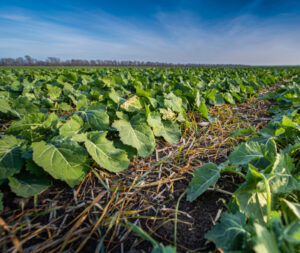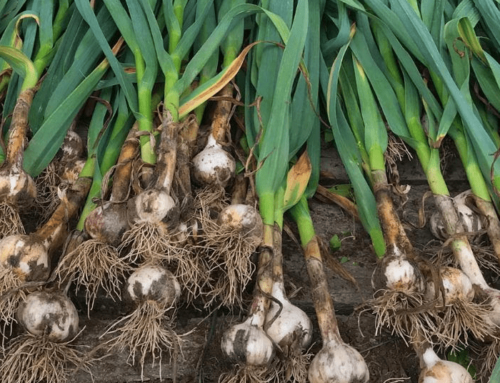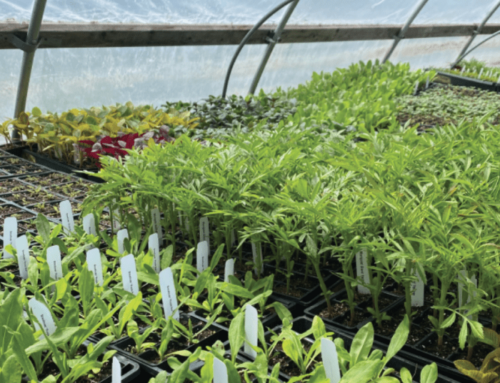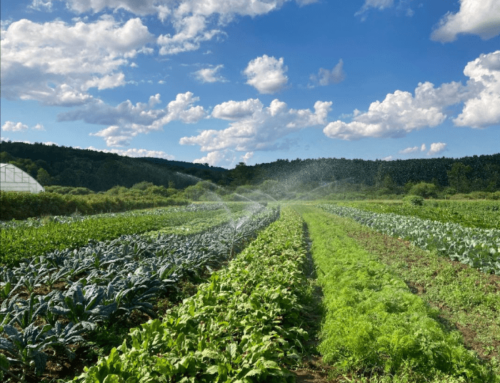By Christine Manuck, NOFA/Mass Soil Health Projects Manager
As with every living thing, what you get out of soil is related to what you put into it. Transitioning our mindset of soil from an inorganic growing medium to a diverse, living ecosystem can allow us to treat our soil as the essential resource that it is for the betterment of our plants and environment.
Healthy soils function as a living system, boasting a diverse community of beneficial organisms and strong soil structure to hold water and nutrients, ultimately improving crop production. We can all identify healthy soil: dark and rich, aggregated and easy to dig into. A smooth silk through which roots and beneficial worms, insects, bacteria, and fungi can work in symbiotic concert with plants. Soil health is directly dependent upon the management practices applied to it, and approaching your farm or garden as a holistic interconnected system can help facilitate proper healthy soil and plant practices for long-term viability and success. Regardless of your soil’s starting point, all soil has the potential for improvement with sustainable management practices that focus on the soil ecosystem as well as plant production.
One common farm and garden management strategy presents an especially strong challenge for establishing a sustainable healthy soil ecosystem: tillage. The regular tilling that is common in both organic and conventional farming creates a cyclical dependence upon further tillage and amendments. Amendments are generally applied as a means to an end: weed control, plant growth, and crop production, with little concern for improving the actual soil itself. Reliance on tillage is particularly problematic in organic production given its lesser usage of synthetic fertilizers and herbicides in contrast to conventional agricultural production. The purported conveniences of tillage are at the expense of soil, the very substance that is so essential to crop viability and productivity, and can lead to loss of organic matter, compaction, and erosion. Reducing tillage can break this cycle, yet, admittedly, tillage reduction is a huge step to take with a lot of practical unknowns, such as how to plant into an untilled bed or field, weed management, and incorporation of plant residues. However, even just a modest tillage reduction can both benefit the soil ecosystem and start to make further tillage reduction more attainable.
No-till gardening and farming doesn’t have to be a hardline elimination of soil disruption, but instead a modification of management practices to improve the soil ecosystem through utilizing cover crops, minimizing soil disruption, and letting biology work to benefit the whole system. Disruptions are minimal and limited to opening and closing the seedbed for planting and harvesting, implemented through permanent rows and beds. No- or low-till management practices can be used to the betterment of both production crops and the soil, with added economic and environmental benefits. Some minimal and conservation tillage systems, such as zone-till and ridge-till, maintain tillage to the upper topsoil layers and within a small portion of rows and ridges. See Caro Roszell’s November 2018 NOFA/Mass Newsletter article “What We Mean When We Talk About Tillage” available here for a broader discussion on tillage systems and practices.
Refocusing our attention on the farm or garden as an interconnected system can be done through sustainable soil management: stopping or reducing tilling, minimizing tractor disturbance, and utilizing cover crops and amendments that benefit both crops and soil. Transitioning to sustainably-managed soils, and grasping how tillage fits into this balance, begins with an understanding of the soil ecosystem.
Understanding Your Soil
Understanding the physical and biological processes that make soil healthy are integral to understanding how a no- or reduced-till system can help support soil health. Key to this is soil organic matter, one of the primary beneficiaries of a no-till garden or farm. Why is soil organic matter so important? Soil organic matter is like the concrete foundation of a house: a strong one will keep your home solid and secure with few structural challenges over time, whereas a weak one will lead to continual problems that need fixing until the sum total of all problems eventually render the home worthless. Similarly, soil organic matter facilitates all of the sustainable life-giving properties to soils: creating structure and air tubes for crop roots to grow strong into, developing structure and pores to allow water to infiltrate after rains and nourish parched crops during droughts, worms and other beneficial insect paths to navigate while consuming crop pathogens, and chemical buffers to regulate crop nutrient availability. Plants are the primary source of organic matter through the crop residues, or decomposing roots, stems, and leaves, that remain on the soil after harvest. Additional inputs, typically compost, also add organic matter. The breakdown of these organic additions result in primary, secondary, and longer-term benefits to the soil, ultimately leading to the structural changes needed to see the full production and environmental advantages attributed to healthy soil.
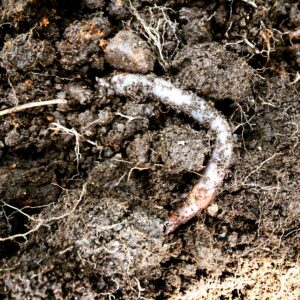
Earthworm in living soil
In addition to playing an essential role in decomposing plants and compost to improve organic matter, earthworms and natural fungi and bacteria, or microbes, are also integral in developing its structure. Soil structure is how the individual particles of soil hold together to create pore spaces, or channels, for air, water, roots, and living organisms to meander through. These living organisms help establish soil aggregates: clumps of soil joined together that are ultimately responsible for its overall structure, developed via their movement through the soil and by producing glues that help hold the soil together. Picture two identical glass jars: one is filled with Hershey’s Kisses, the other is filled with chocolate chips. The large Hershey’s Kisses would create larger spaces, or pores, in the jar, into which you could fit smaller things, such as smaller candies, air, and water. Conversely, in the chocolate chip jar, the smaller chocolate chips would nestle into the free spaces more easily, making it possible, but harder, to fit additional smaller candies, air, and water. The same is true for your soil: larger soil aggregates form a beneficial combination of small, medium, and large pores, accommodating more roots, beneficial worms, microbes, air, and water, whereas poorly aggregated soil is predominated by smaller pores that cannot accommodate earthworms, roots, air, and plant-available water. The better the aggregates hold together, the better it is for crops, the soil ecosystem, and overall soil health. Well-aggregated soil can form individual clumps that look like cottage cheese, turning the soil as a whole into an absorptive sponge while establishing essential growth and movement channels for plant roots, water, and beneficial soil dwellers.
Maintaining continual soil cover through plant residues and utilization of soil cover crops is integral to improving soil organic matter and structure. Cover crops aid in developing soil structure by releasing sugars from their roots that help hold the soil together. Their roots also offer a host for fungal mycorrhizae, which further aid in aggregating soil particles. Cover crops extend these soil health benefits beyond the growing season while offering myriad benefits to the soil, for cash crops, and to the ecosystem as a whole. Cover crops provide soil cover to minimize erosion and carbon loss while enriching the soil with crop-available nutrients, suppressing weeds, increasing water infiltration and organic matter, improving structure, and attracting beneficial insects. Cover and cash crop plant residues, when left as a soil cover or mulch as in a no-till system, can further improve soil health and crop production by decomposing into organic matter to further enrich the soil while minimizing soil erosion, precipitation runoff, and moisture loss to evaporation. Leaving crop residues in place after harvest and cover cropping create a continual soil cover and living roots for stabilization before they decompose into organic matter.
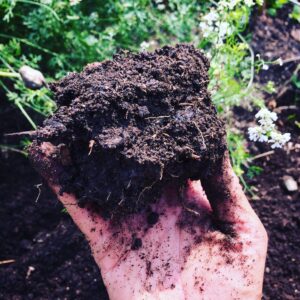
A large soil aggregate
Applying Tillage Management for Soil Health
Now think about soil management. Returning to the earlier analogy, running a knife through the jar of Hershey’s Kisses would chop them into smaller pieces, making them smaller and divided until they settle over time into themselves, without the large, intact Kisses to create open pores. The same can be said for soil tillage: tilling breaks the aggregates into smaller pieces, initially yielding fluffy soil that is easy to plant into, but the absorptive sponge is gone once the soil settles back into itself, with fewer channels for water absorption, microbes, and root growth. Systems with no or minimal tillage both maintain and improve upon the desirable functions of plant roots, earthworms, and microbes by not destroying these precious channels with the same frequency as if conventionally-tilled. The lack of soil disruption functions as a positive feedback for soil development, leading to greater improvements over time. The benefits of a reduced-till system are clear, yet many of us still have questions:
- How are they put into practice?
- How is it possible to deal with the weeds that will inevitably pop up?
- How can a seedbed be prepped with crop residues in place?
- What do I do with my cover crop when I need to plant, and when do I do it?
- Is it possible to continue some tillage and still reap these soil benefits?
- How do I make it work for me?
The NOFA Summer Conference (July 30-August 6, 2021) hosts speakers that will address just this: the functional implementation of a no-till system for crop production while improving soil and ecosystem health.
In a pre-conference Fireside Chat, Dr. Christine Jones and Ray Archuelta, two regenerative soil health consultants, will be discussing regenerative farming practices that actually work; see this link for more information on the July 15 evening event.
The Conference’s keynote speakers, Jen Salinetti and Daniel Mays, will be discussing their own experiences, decisions, challenges, and advantages in transitioning to no-till systems during their No-Till Keynote Panel: From Purpose to Practicality (Wednesday, August 4, additional information available here). Both speakers have transitioned their tillage-dependent farms into profitable no-till operations with an emphasis on soil regeneration and minimal soil disturbance. Underscoring the transition from tillage to a no-till system as a continual learning process, the role of trial and error, and the imperfections of this developing system, will be addressed with functional strategies and solutions.
While embracing the no-till or reduced-till approach, you can benefit the health of your soils through regenerative farming practices that increase biological diversity and support a well-balanced ecosystem.
To learn more about no-till, regenerative, or organic farming and gardening, register for the NOFA Summer Conference today. Also check out our upcoming events, including our min-till farmers call, where farmers and gardeners exploring reduced tillage methods can have an informal discussion, pose questions to each other, and share resources, suggestions, and ideas about tillage reduction. For the rest of 2021 and into 2022 we will have several upcoming on-farm events spotlighting the benefits of tillage reduction practices; please keep an eye on the NOFA/Mass events page for updates.

